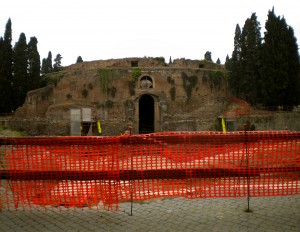Sometimes (okay, all the time) research papers are no fun. So I wasn’t looking forward to last Monday, when all my final papers were due. After countless espressos, a great study play list that I grew to hate after the 10th repeat, and awkward looks from people in the library who would comment, “Wow, you’re still here?” I was thrilled to hand in my papers and sleep for the next two days. In spite of all of this, I can grudgingly admit that I found myself really passionate about one of my paper topics: The Mausoleum of Augustus.
Built in 31 BC. by Emperor Augustus, his Mausoleum stood a monumental 45 meters across and 90 meters high, a cylindrical structure covered in dazzling white marble. The first of many buildings constructed during his career, Augustus would eventually change the face of Rome, taking the city that was once sun-baked brick and leaving it a “city of marble”. Barbarians would later sack the Mausoleum of Augustus in the 5th century and steal the emperor’s remains. The Mausoleum fell into ruin; it would later become a fortress in the 11th century, and in following centuries a garden, bullring, and concert hall. Benito Mussolini cleared the area in 1939, restoring the brick substructure to its original shape in Piazza Augusto Imperatore. Today, it lies quietly behind a chain-link fence, signless and anonymous.
Although I am not the biggest fan of Elizabeth Gilbert’s “Eat, Pray, Love”, I really enjoy her reflections on the Mausoleum of Augustus or “Augusteum”:
“Today the Augusteum is one of the quietest and loneliest places in Rome, buried deep in the ground. The city has grown up around it over the centuries. Traffic above the monument spins in a hectic circle, and nobody ever goes down there- from what I can tell- except to use the place as a public bathroom. But the building still exists, holding its Roman ground with dignity, waiting for the next incarnation…”
“I look at the Augusteum, and I think that perhaps my life has not actually been so chaotic, after all. It is merely this world that is chaotic, bringing changes to us all that nobody could have anticipated. The Augusteum warns me never to get attached to any obsolete idea about who I am, what I represent, whom I belong to, or what function I may once have intended to serve. Yesterday, I may have been a glorious monument to somebody, true enough- but tomorrow I could be a fireworks depository. Even in the eternal city, says the silent Augusteum, one must always be prepared for riotous and endless waves of transformation.”
LH

